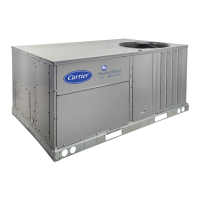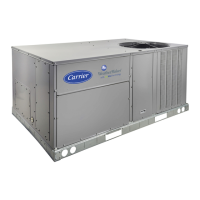maintaindiagnostics,althoughtheenduserwill seea
Dehumidificationmodeatthedisplay.In addition,for
multi-stagecoolingunitsthecoolingcontrolpointwill
besetto Configuration-+DEHU-+D.C.SP (no SASP
reset is applied).
• Reheat When Cooling Demand is Present -- For reheat
control during dehmnidification: If reheat follows an
offset subtracted from return-air temperature (Configu-
ration---_DEHU---_D.SEL = 2), then no heating will be
initiated and the alarm relay will be energized. If
Configuration--cDEHU-+D.SEL = 1 and Configura-
tion--+HEAT--cHT.(T = staged gas or hot water valve,
then the selected heating control type will operate in the
low heat/modulating mode.
• The heating control point will be whatever the actual
cooling set point would have been (without any supply
air reset applied).
• Reheat During Vent Mode -- If configured (Configura-
tion--+DEHU--+D.V.(T = 0), the heating control point
will be equal to RAT - D. ERA. If configured (Configu-
ration--+DEHU--+D.V.(T 1), the heating control point
will be equal to the D. V.HT set point.
Ending Dehumidification and Reheat Control -- When ei-
ther the humidity sensor fall 5% below the set point ((bnfigu-
ration-+DEHU-+D.RH.S) or the discrete input reads
"LOW", the Dehumidification mode will end.
Temperature Compensated Start -- This logic is
used when the unit is in the unoccupied state. The control will
calculate early Start Bias time based on Space Temperature
deviation from the occupied cooling and heating set points.
This will allow the control to start the unit so that the space is at
conditioned levels when the occupied period starts. This is
required for ASHRAE 90.1 compliance. A space sensor is re-
quired for non-linkage applications.
SETTING UP THE SYSTEM -- The settings for tempera-
ture compensated start can be found in the local display under
(bnfiguration --¢UNIT.
ITEM EXPANSION RANGE UNITS CCN POINT
TCS.C Temp,Cmp,Strt,Cool Factr 3 - 60 rain TCSTCOOL
TCS.H Temp,Cmp,Strt,Heat Factr 3 - 60 rain TCSTHEAT
TCST-Cool Factor (TCS. (3 -- This is the factor for the start
time bias equation for cooling.
TCST-Heat Factor (TCS./-!) -- This is the factor for the start
time bias equation for heating.
NOTE: Temperature compensated start is disabled when these
factors are set to 0.
TEMPERATURE COMPENSATED START LOGIC --
The following conditions must be met:
• Unit is in unoccupied state.
• Next occupied time is valid.
• Current time of day is valid.
• Valid space temperature reading is available (sensor or
DAV-Linkage).
The algoritlun will calculate a Start Bias thne in minutes us-
ing the following equations:
If (space temperature > occupied cooling set point)
Start Bias Time = (space temperature - occupied cooling set
point)* TLS. C
If (space temperature < occupied heating set point)
Start Bias Time = (occupied heating set point - space
temperature)* TLS.H
When the Start Bias Time is greater than zero the algofitlun
will subtract it from the next occupied thne to calculate the new
start time. When the new start time is reached, the Temperature
Compensated Start mode is set (Operating Modes-+MODE--9
T.CS!), the fan is started and the unit controlled as in an
occupied state. Once set, Temperature Compensated mode will
stay on until the unit goes into the Occupied mode. The Start
Bias Time will be written into the CCN Linkage Equipment
Table if the unit is controlled in DAV mode. If the Unoccupied
Economizer Free Cool mode is active (Operating Modes--€
HVAC = "UNOCC FREE COOL") when temperature com-
pensated start begins, the Unoccupied Free Cool mode will be
stopped.
Carrier Comfort Network _ (CCN) System -- It
is possible to configure the (_l_fortLink TM control to partici-
pate as an element of the Carrier Comfort Network (CCN) sys-
tem directly from the local display. This section will deal with
explaining the various progralmnable options which are found
under the CCN sub-menu in the Configuration mode.
The major configurations for CCN progralmning are locat-
ed in the local displays at (bnfiguration _CCN See Table 86.
CCN Address (CCNA) -- This configuration is the CCN ad-
dress the rooftop is assigned.
CCN Bus Number (CCNB) -- This configuration is the CCN
bus the rooftop is assigned.
CCN Baud Rate (BAUD) -- This configuration is the CCN
baud rate.
CCN Time/Date Broadcast (TM.DT) -- If this configuration
is set to ON, the control will periodically send the time and date
out onto the CCN bus once a minute. If this device is on a CCN
network then it will be important to make sure that only one
device on the bus has this configuration set to ON. If more than
one thne broadcaster is present, problems with the time will
OCCUE
NOTE: Only the time and date broadcaster can perform
daylight savings time adjustments. Even if the rooftop is stand
alone, the user may want to set this to ON to accomplish the
daylight/savings function.
CCN OAT Broadcast (OAT.B) -- If this configuration is set
to ON, the control will periodically broadcast its outside-air
temperature at a rate of once every 30 minutes.
CCN OARH Broadcast (ORH.B) -- If this configuration is
set to ON, the control will periodically broadcast its outside air
relative humidity at a rate of once every 30 minutes.
CCN OAQ Broadcast (OAQ.B) -- If this configuration is set
to ON, the control will periodically broadcast its outside air
quality reading at a rate of once every 30 minutes.
Global Schedule Broadcast (GS.B) --If this configuration is
set to ON and the schedule number (S(!-L.N) is between 65 and
99, then the control will broadcast the internal time schedule
once every 2 minutes.
CCN Broadcast Acknowledger (B.ACIO -- If this configu-
ration is set to ON, then when any broadcasting is done on the
bus, this device will respond to and acknowledge. Only one de-
vice per bus can be configured for this option.
Schedule Number (SC!-LN) -- This configuration determines
what schedule the control may follow.
SCH.N = 0 The control is always occupied.
SCH.N = 1 The control follows its internal time sched-
ules. The user may enter any number
between 1 and 64 but it will be overwritten
to "1" by the control as it only has one
internal schedule.
SCH.N = 65-99
The control is either set up to receive to a
broadcasted time schedule set to this
number or the control is set up to broadcast
its internal time schedule (GS.B) to the
network and this is the global schedule
number it is broadcasting. If this is the case,
then the control still follows its internal time
schedules.
71

